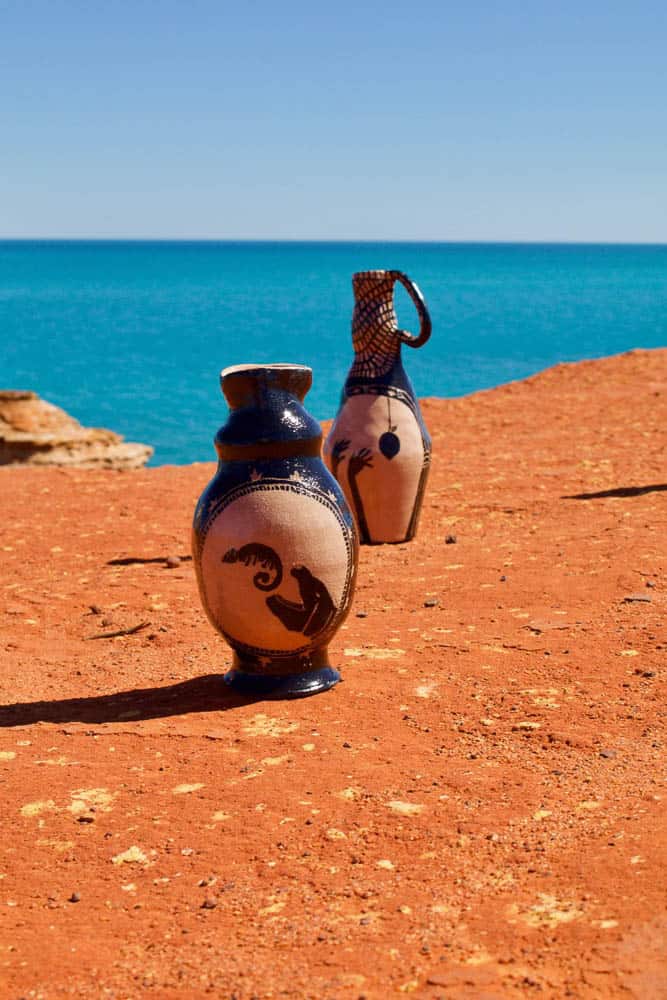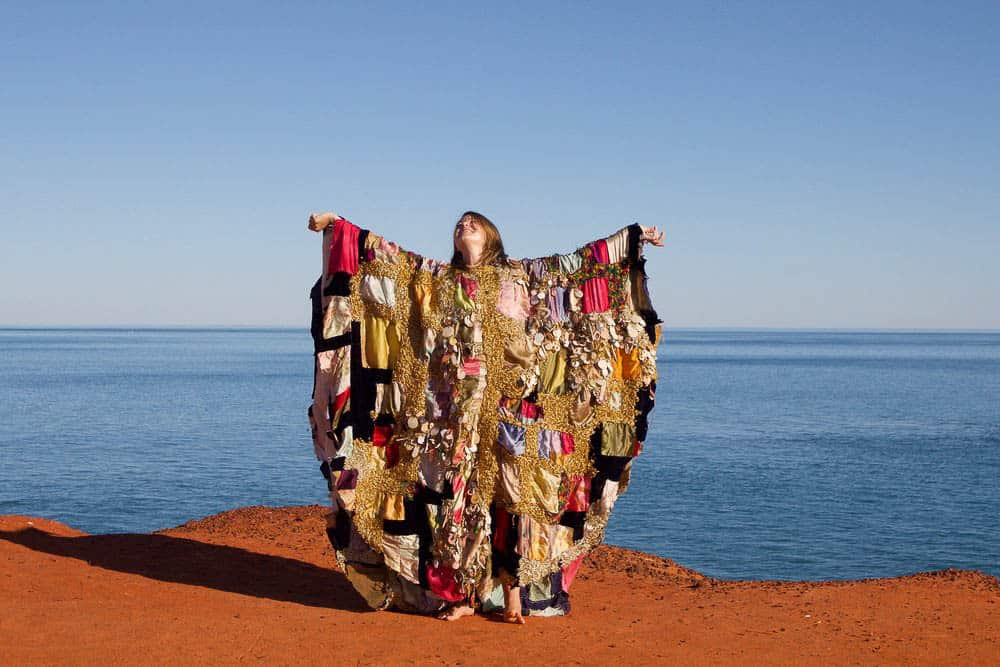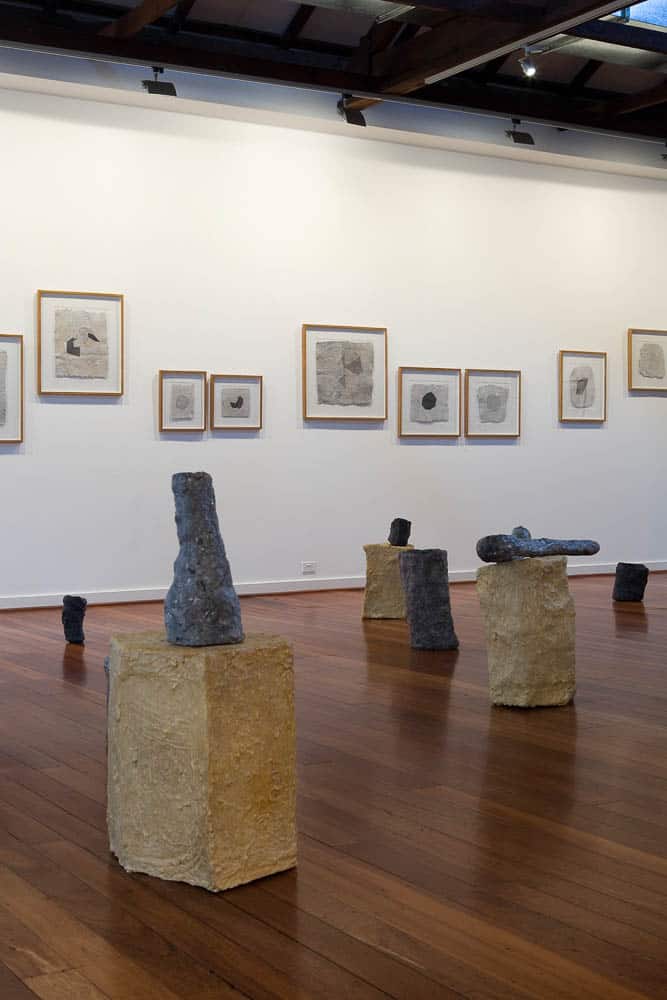- Clare Peake, Intermediate Pots (detail), 2015- ongoing. Ceramics, dimensions variable. © Courtesy the artist.
- Clare Peake, A Sorcerer’s Dress, 2016- ongoing, Studio scraps, test pieces, failures and project remnants, 120 x 145 cm. . © Courtesy the artist. Photographs by Amelia Luscombe
- Clare Peake, Intermediate Pots (detail), 2015- ongoing. Ceramics, dimensions variable. © Courtesy the artist.
- Clare Peake, Installation view, The Indeterminacy Principle, 2007. Mixed media, dimensions variable. © Courtesy the artist.
- Clare Peake, Installation view, A comprehension of the farthest points, 2013. Recycled past works, studio scraps, graphite on paper. Dimensions variable. © Courtesy the artist. Photograph by Bo Wong
Clare Peake delivered me one of my first artistic revelations.
We were in second year of art school at Curtin University in Perth, around 2004. It was an end of semester review and I had spent my time very traditionally romancing the window of the page in the print studio. Clare had arranged a sequence of objects around the perimeter of one of those cold rooms that exist nowhere beyond the arts – smudgy white walls and a concrete floor painted enamel grey, a sink in the corner. I remember sticks wrapped in foil and a babushka-doll concatenation of red buckets in descending size with a ping-pong ball at the core and my initial thought: I am lost. Once I drained my mind of worry I saw that each singular arrangement in the sequence bore a relationship—in colour, form, or process—with the next and preceding, forming a loose chain of association. Suddenly it was as though I were standing in the centre of a room-sized zoetrope that when set in motion would show the supernatural metamorphosis of a single form. There it was: not an image, but the world itself. Ever since then I’ve thought of Clare as a kind of magician.
A decade or so later it’s embarrassing to publicly admit to this naïve coming-to-understanding, but we all have them. And it would otherwise be dishonest to write about Clare as though I have stood in front of her work as a fully-formed person, rather than as someone working through not-knowing to thinking-I-know to realising-I-don’t, and repeat. In fact, Clare’s work seems to invite those who encounter it to adopt this very position: a fragility and incompleteness symmetrical with its own. I understand this as generosity, an invitation to work through it together. However, it would also be dishonest to write about Clare as though I am able to stand in front of her work at all. She lives in Broome now, roughly two thousand, three hundred and fifty kilometres from where I am, in Perth. I see her work like this, in memory, or by lurking her website.
With the birds-eye view of time that a website offers, it is possible to parse three distinct eras of Clare’s practice. Installations from 2007 and eight follow the trajectory of my second-year remembrance, arrangements of parts within delineated arenas like a rectangle marked on the floor in tape or the confines of spherical or wandering tabletops. These arrangements have titles that suggest a groping for order in a cloud of unknowing: The Indeterminacy Principle, The Gordian Knot, the latter a reference to the legend of an “intractable” problem solved through lateral thinking. After this is a three-year hiatus returned from in 2011 with Pilot, a muted dialogue between sculpture and drawing that sets the tone for the next few years: glass, unfired earth and solemn graphite-grey form abstract landscapes of either cosmic or microscopic proportions. Rock-forms appear regularly in both two and three dimensions, as well as the bell and bowl and the circle, sometimes composed of microscopic points or a structural mesh. The fragment remains, but it is as though a stable world is beginning to be pulled from temporary chaos. Clare’s material lists during this period hint at a transformative reckoning. Pulped into lumpy columns and sheets of paper are “recycled past works and studio scraps”. Then, there is Broome, and with it the appearance of a specific, real-life landscape, and figures.
In the months after her arrival in Broome, Clare began working on the series Intermediate Pots. So far she has produced 90 and the marker “2015 – ongoing” suggests there may be more. These terracotta vessels are more elaborately finished than their predecessors, although they remain just wrong enough to be right, with handles and more complex ribbed silhouettes built in memory of Grecian urns, pitchers and vases. Each vessel is glazed with a stylised narrative scene in black-on-orange that depicts daily life in Broome with a dream-like resonance. A man, woman and dog, sometimes wearing a crown of flowers or a mermaid tail, appear regularly. Hands hover around a form that could be a potato or a void; a weather forecast is repeated in running script. At the Art Gallery of South Australia, where they were a contender in the inaugural 2017 Ramsay Prize, a selection of pots were arranged in a neat, dark cabinet of shelves, but Clare also presents them documented against the bright orange-and-teal-infinity of the Broome horizon looking out to sea, where they share the frame with rusted ring-pulls and the back end of a wiry dog the size of a small pony. These apparently-casual documentary images appear as integral to the series as their display at a remove from the place of their making, a reminder that the object remains always in motion, orbiting its source. A more recent series of digital collages has them copy-pasted against photographs of the same life that they depict in their cartoon-like vignettes—candid, low-resolution snaps of a football game on tv in a bar, a caught fish, an orange gravel road—creating a double-barreled abstraction of time passing in a place where momentousness and monotony have been all mixed up.
Perhaps this contradictory sensation—time that rushes and stretches simultaneously like treacle, dumb absurdity in tragic things and vice versa—belongs specifically to life in a young and precarious colony grafted onto one of the oldest places in the world. This is speculation: I have never been to Broome, but I did grow up in a different regional Western Australian city with one road in and one road out, a road eventually augmented by a bypass that meant it could be avoided entirely, so I do know something of the drip-feed feeling of long regional summers and the weird thrum of a violent past disguised by quiet and too-wide streets. In an attempt to gauge the specific tenor of Broome life I revisit the images Clare has been posting on social media of the cyclonic apocalypses that appear this season to be wrought consistently upon it. In another tab, I click through a link-chain to learn that cyclones (wangal jarrangu) are usual for the wet Yawura season of Man-gala (December – March). In late January, rain overflowed the sewage treatment ponds in Roebuck Bay and that one road in an out was closed, causing residents to panic-buy supplies of food. Clare’s feed shows an image of some large beef bones and sad oranges on otherwise empty supermarket shelves. When I ask her about how this place has affected her work, she says: “There is this really strong sense, to me anyway, that everybody is always waiting for something – tides to change, weather to change, rain, tourist season, wet season, dry season, mail… so much waiting. It’s like a giant purgatory and I really see the whole place as my practice amplified. It’s like if someone were to ask me what my practice looks like I’d say it looks like Broome.”
Clare connects the effect of wet-season weather with both her process of making and her feelings about it: “Slow, anxious, waiting for ideas, tired, heavy.” Superficially, these descriptions sit at odds with the low-fi quirk of her objects, an apparent a lightness of touch, and with themes of transcendence or redemptive transformation evoked by more recent works, particularly A Sorcerer’s Dress. This also-ongoing project repurposes studio remnants and failures—squares of magenta and purple and pale mustard fabric encrusted with patches of ovoid scales and other talismans—into a vestment-like cloak embellished with gold. It too is documented against the same bright horizon. Clare is wearing it, captured in a happy-awkward dance that seems directed at the sun. She describes her excitement at including it in an exhibition at Wesley Church later in the year—the site of one of her own transformative art encounters, with a Bill Viola projection as a teenager—where its rhetorical evocation of sorcery and the sacred will rub up against the specific narrative of Biblical salvation.
Clare’s practice is speckled with references to different forms of spiritual practice: God, sorcery, ghosts, torment, relics—she mentions she is currently working on a ring in collaboration with designers Rose Megirian and Max Butcher that will hold the ashes of her Visual Diaries since 2015—redemption, perhaps even transubstantiation, in the rescue and elevation of ordinary things. Purgatory. Its most basic magic, however, is in its embodiment of time. A Sorcerer’s Dress is a garment laden with waiting. Its absorption of the remainders of making aims for a lossless representation of time that includes frustration and failure as well as victory, the reincarnation rather than the killing or saving of time. The wobble this produces between lightness and weight and slowness and speed echoes the effect of time passing and its recollection in memory—which occurs everywhere, for everyone I’m sure, not just in Broome—with similar fluctuations of density and speed triggered by place, smell, matter. The result is a holy trinity: Clare’s objects are a container for time, a representation of how it feels, and a portal for travelling through it.
Back to the now. In Perth, it is 33 degrees, finally a dry heat. The weather that hit Broome reached us too and in one day we were inundated with the average rainfall of a combined four months. Since then it has been an unseasonably humid transition from Birak to Bunuru, the driest, hottest season of the year in the Noongar calendar. With my window open, I can watch grass flies whirling in front of the loquat and almond trees planted by our landlord. Inside I am caught in the flypaper of the internet, procrastinating. From Wikipedia I learn the pearling industry that precipitated Broome’s foundation in the early 1880s was supported initially by “slave labour and later slave-like labour”, a troubling distinction. I learn that Cable Beach is named so because a telegraph cable from Java laid in 1889 comes ashore there. After this, I am sucked into a google spiral looking at pictures of undersea internet cables, which grow knobbly sponges and are chomped on by sharks. How vulnerable abstractions become once contained in a body. A comment on a Youtube clip of this footage: that’s one megabite (sic). Outside the sky is the exact same shade of blue as the sky behind Clare in her Sorcerer’s Dress, a softly vivid Fra Angelico lapis lazuli. All of these fragments to contend with. I scroll to the bottom of her raft of images and find a hyperlink that closes the loop: “Back to Work.”
Author
 Gemma Weston is curator of the Cruthers Collection of Women’s Art at the University of Western Australia, where she is currently working towards the exhibitions, No Second Thoughts, drawing from the State Library of WA archive of the ARTEMIS Women’s Art Forum, and Authentic Determination, a response to the collection by Adelaide-based artist and curator Brigid Noone, to be presented at Lawrence Wilson Art Gallery in 2018. Gemma is also one-third of the artist-run-conspiritorium Pet Projects and she occasionally exhibits and publishes as Gemma Watson.
Gemma Weston is curator of the Cruthers Collection of Women’s Art at the University of Western Australia, where she is currently working towards the exhibitions, No Second Thoughts, drawing from the State Library of WA archive of the ARTEMIS Women’s Art Forum, and Authentic Determination, a response to the collection by Adelaide-based artist and curator Brigid Noone, to be presented at Lawrence Wilson Art Gallery in 2018. Gemma is also one-third of the artist-run-conspiritorium Pet Projects and she occasionally exhibits and publishes as Gemma Watson.






